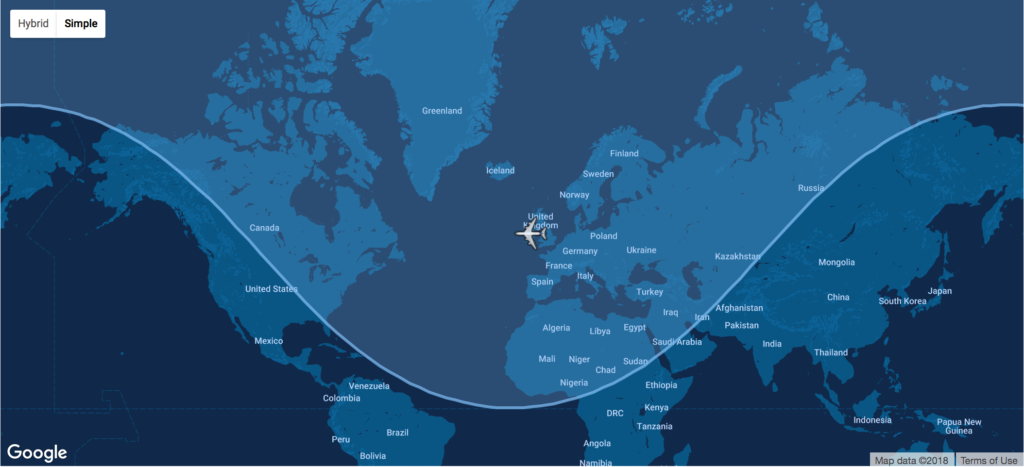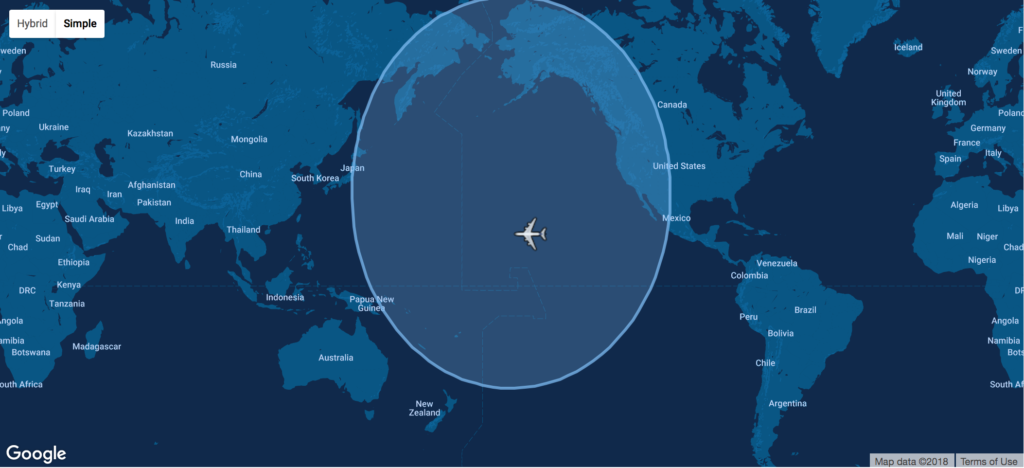![]()
Airbus A220 ETOPS Certification Opens the Door to Hawaii Service
・Airbus A220 engines received 180-minute ETOPS certification
・Pratt & Whitney is the exclusive engine manufacturer for the A220 series
・180-minute ETOPS opens the door to Hawaii
Airbus recently unveiled its newest aircraft family, the Airbus A220-100 and A220-300 – formerly CS100 and CS300. The ‘new’ aircraft is the smallest offered by Airbus and serves the 100 to 150-seat market. The aircraft is already in service (as the CS100 and CS300) with Air Baltic, Korean Air, and SWISS.
JetBlue ordered 60 A220 aircraft to replace its Embraer E190 fleet, spurring another round of ‘JetBlue to Europe’ speculation. With a range of 3,100nm (~5,700km), the A220 can reach U.S. cities like Boston and New York from London, for example.

Airbus A220 Range from London | Image: Airbus
The Significance of ETOPS 180: Hawaii
The Federal Aviation Administration (FAA) certified Pratt & Whitney’s A220 engines for 180-minute extended operations (ETOPS).
ETOPS – Extended-Range Twin-Engine Operational Performance Standards – refers (in very simple terms) to the number of minutes aircraft can fly over remote areas. Achieving 180-minute ETOPS certification means a twin-engine plane like the A220 can fly for 180 minutes (3 hours) on one engine.
Translation: the A220 can fly to Hawaii.
Airbus A220 Range
From Honolulu, the A220 can comfortably reach Los Angeles (LAX), San Francisco (SFO), Seattle (SEA) and other West Coast gateways:

A220 Range from Honolulu | Image: Airbus
Will JetBlue serve Hawaii?
The responses below are not provided or commissioned by the bank advertiser. Responses have not been reviewed, approved or otherwise endorsed by the bank advertiser. It is not the bank advertiser's responsibility to ensure all posts and/or questions are answered.
10 comments
While possible, I doubt JetBlue will begin Hawaii service. They have no West Coast hub or focus city from which to operate. Plus, they have an established relationship with Hawaiian Airlines. And with the increasing competition from all existing carrier on West Coast to Hawaii routes and the imminent entry of Southwest, I’m sure JetBlue won’t be in a big hurry to open new, risky routes here 😉
Thanks for your comment, Kyle! Great point – especially when considering JetBlue’s inability to grow its LGB operation. However, the same could also be said for entering the (very) crowded NYC/BOS to LHR/LIS/DUB markets.
I do think there’s some room for JetBlue to grow on the West Coast beyond just LGB. PDX or SAN perhaps?
Good thoughts, but just to help out a little, LGB is still a focus city “hub” for Jetblue. That title has not been removed yet even though LGB city council has haulted the growth.
Thanks for chiming in, James. Where do you think JetBlue’s A220s are headed?
Mostly the east coast at first to clear out the E190’s, then I’m sure you’ll see some , maybe London and then fill out the West on some short hauls. While rerouting the A320’s for some trans con along with the A321neo. It’s going to be a lot of changes and direction in the coming years.
True, though I heard they may be considering scaling back operations there due to the inability to grow and lackluster performance at LGB. Plus, launching a flight between LGB and Hawaii may not be the best idea either, as Hawaiian recently began LGB-HNL service. And from what I hear, Hawaiian’s flights aren’t exactly busy. They’re currently operating the larger A321neo on the route, though.
Either way, while the A220 could work on really small markets from the West Coast, I simply don’t think it’s enough airplane to work.
You may see Hawaii being served when Hawaiian finally gets rid of the 717. That may not happen for another 10 years. The A220 could then, if it’s robust enough, see service within Hawaii and then maybe crazy service from Hawaii to small airports, like Spokane, Medford, Fresno, Monterey, Santa Barbara, Reno, etc.
Thanks, Derek. Great point – do you think it’s a viable aircraft for interisland service?
I’d love to see the A220 or MRJ replace the 717 in Hawaiian’s inter-island network, but robustness is an issue. The use Hawaiian’s 717s see are extreme. Not only in the number of turns, but in the way the engines must operate on these short routes. There’s little to no cruising, so the engines don’t get much time to cool after the rigors of takeoff.
I’ve heard that Aloha had tried to use 737NGs for this service, but that the CFM power plants required too much extra maintenance and the size of the aircraft, of course, was too much for AQ. That’s a big part of why they stuck with the 732, if that story is correct. The 717’s BMW Rolls-Royce BR700, apparently, are well suited for the task, not only with Hawaiian, but with Qantas too. But both the A220 and MRJ use variants of the PW1000, so we’ll see!
Thanks for all of the detail – very interesting! How are the ‘Ohana ATRs performing?
I have wonderful memories of those AQ interisland 732s. Nothing like ’em today 🙂